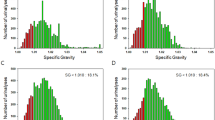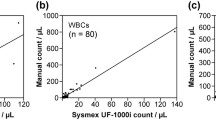Abstract
The appearance of red blood cells in the urine may be the result of disease of any segment of the urinary tract. To determine whether there might be a distinguishing characteristic of the urinary red cells which appear during glomerular disease but is absent in other urinary tract diseases, the mean corpuscular volumes (MCV) of urinary and blood erythrocytes were measured by a Coulter counter in 34 children with haematuria. Diagnosis of the underlying renal or urinary tract disease was made by clinical and laboratory findings, including radiological investigations, renal biopsy and cystoscopy. The ratio of the urinary erythrocyte MCV to that in blood (Umcv/Bmcv) was compared with the diagnosis. The Umcv/Bmcv ratio was less than 1.0 in all children with glomerular disease and was greater than 1.0 in all but 1 of the patients with non-glomerular disease. This study suggests that the Umcv/Bmcv ratio provides a simple and useful technique for distinguishing between glomerular and non-glomerular haematuria. Such determination would help in guiding appropriate diagnostic evaluation.
Similar content being viewed by others
References
Schifferli JA (1982) Primary renal origin of hematuria: importance of RBC casts and urinary sediment examination technique. Am Heart J 103:573–574
Sigala JF, Bivava CG, Hulter HN (1978) Red blood cell casts in acute interstitial nephritis. Arch Intern Med 138:1419–1421
Birch DF, Fairley KF (1979) Hematuria: glomerular or nonglomerular. Lancet II:845–846
Fairley KF, Birch DF (1982) Hematuria: a simple method of identifying glomerular bleeding. Kidney Int 21:105–108
Rizzoni G, Braggion F, Zachello G (1983) Evaluation of glomerular and non-glomerular hematuria by phase contrast microscopy. J Pediatr 103:370
Thal SM, De Bellis CC, Iverson SA, Schumann GB (1986) Comparison of dysmorphic erythrocytes with other urinary sediment parameters of renal bleeding. Am J Clin Pathol 86:884–887
Ramon GV, Pead L, Lee HA, Maskell R (1986) A blind controlled trial of phase-contrast microscopy by two observers for evaluating the source of hematuria. Nephron 44:308
Shichiri M, Oowada A, Nishio Y, Tomito K, Shiigai T (1986) Use of autoanalyser to examine urinary red cell morphology in the diagnosis of glomerular hematuria. Lancet II:781–782
Coulter Electronics (1982) Instruction and service manual for the Coulter counter
Fassett RG, Horgan B, Matthew TH (1982) Detection of glomerular bleeding by phase-contrast microscopy. Lancet I:1432–1434
Van Iseghem P, Hanglustaine D, Bollens W, Michielson P (1983) Urinary erythrocyte morphology in acute glomerulonephritis. Br Med J 287:1183
Author information
Authors and Affiliations
Rights and permissions
About this article
Cite this article
Öner, A., Ahmad, T.M., Beşbaş, N. et al. Identification of the source of haematuria by automated measurement of mean corpuscular volume of urinary red cells. Pediatr Nephrol 5, 54–55 (1991). https://doi.org/10.1007/BF00852845
Received:
Revised:
Accepted:
Issue Date:
DOI: https://doi.org/10.1007/BF00852845




